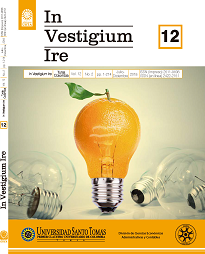Cocoa-grower women managers of sustainable development in colombian post-conflict: Maripi municipality
Main Article Content
Abstract
This study is part of the project called "Familiar cocoa agriculture and associativity in the West of Boyacá" managed by the GIDICON Group of the Pedagogical and Technological University of Colombia. The research developed tries to highlight the transcendental role that the cocoa-grower woman has played in the sustainable regional development of the Municipality of Mari pi Boyacá in the post-conflict period. To this end, from the case study, in the association ASOCAPAZ, it is evident how the woman with her enterprising spirit is the protagonist of sustainable development: (i) in the social sphere, generating actions from the rural family, in the search of the countryside rebirth as an opportunity for inclusion; (ii) in the economic sphere, its leadership supports the activities necessary to overcome poverty; and (iii) in the environmental perspective, their actions contribute to the application of Good Environmental Practices and Good Agricultural Practices, in this sense, the substitution of crops allows an important improvement in the environment of the Municipality of Maripi.
Article Details
How to Cite
Aparicio Peña, D. C., Medina Salazar, G., & Ramírez, M. (2019). Cocoa-grower women managers of sustainable development in colombian post-conflict: Maripi municipality. In Vestigium Ire, 12(2), 187-200. Retrieved from http://revistas.ustatunja.edu.co/index.php/ivestigium/article/view/1728
Issue
Section
Artículos Núm. 12-2
Investigium Ire of http://revistas.ustatunja.edu.co/index.php/ivestigium is licensed under a Creative Commons Attribution-NonComecial-NoDerivatives 4.0 International (CC BY-NCND 4.0)
References
Alcaldía de Maripí. (2017). Boyacá. Obtenido de: http://www.maripi-boyaca.gov.co/informacion_general.shtml.
DANE (2014). 3er. Censo Nacional Agropecuario. Boletín técnico mujer rural.
Departamento Nacional de Planeación; Ministerio de Agricultura y Desarrollo Rural. (2003). Bogotá.
Martínez, l., & Baeza, M. (2017). Enfoques de género en el papel de la mujer rural en la agricultura cubana. Revista Prolegómenos Derechos y Valores, 20(39), 29 -38. doi: http://dx.doi.org/10.18359/prole.2721.
Minsalud (2015). Las mujeres campesinas: su gran aporte a la agricultura familiar y la economía productiva.
Municipio de Maripí. (2016). Plan de Desarrollo Municipal.
NUD (2011). Informe de Desarrollo Humano Colombia de 2011 - Mujeres Rurales, Gestoras de Esperanza: http://www.revistahumanum.org/revista/tri ple-discriminacion-para-las-mujeres-rurales
ONU (2008). La mujer rural en un mundo cambiante: oportunidades y retos. Recuperado de: http://www.un.org/womenwatch/daw/public/w2000/Rural%20Women%20(Spanish).Pdf
ONU. (199 5).1 nforme de la Cuarta Conferencia Mundial sobre la Mujer. Beijin. Obtenido de: http://www.un.org/womenwatch/daw/beijing/pdf/Beijing%20full%20report%20S.pdf
Pineda, A. (2018). El cacao, una apuesta para la transformación del territorio del occidente de Boyacá. Bogotá.
Oficina de las Naciones Unidas contra la Droga y el Delito-UNODC. (2006). Monitoreo de Cultivos de Coca 2005, 117. Recuperado a partir de: https://www.unodc.org/pdf/andean/Colombia_coca_survey_2005_es.pdf
Oficina de las Naciones Unidas contra la Droga y el Delito (UNODC) http://www.biesi mci.org/1licitos/cultivosilicitos/cocampios.html
ONU MUJERES Asamblea de Mujeres Populares y Diversas del Ecuador (2013). SOBERANÍA ALIMENTARIA Y MUJERES Instituto de Estudios Ecuatorianos.
RED UNIDOS. (2015). Ficha Territorial de Logros Maripí. Prosperidad Social.
Ruiz, C. F. (2012). Plan Estratégico Departamental de Ciencia, Tecnología e Innovación de Boyacá, 2022.
UNODC Naciones Unidas. (2012). Cultivos de coca estadísticas municipales. Bogotá.
DANE (2014). 3er. Censo Nacional Agropecuario. Boletín técnico mujer rural.
Departamento Nacional de Planeación; Ministerio de Agricultura y Desarrollo Rural. (2003). Bogotá.
Martínez, l., & Baeza, M. (2017). Enfoques de género en el papel de la mujer rural en la agricultura cubana. Revista Prolegómenos Derechos y Valores, 20(39), 29 -38. doi: http://dx.doi.org/10.18359/prole.2721.
Minsalud (2015). Las mujeres campesinas: su gran aporte a la agricultura familiar y la economía productiva.
Municipio de Maripí. (2016). Plan de Desarrollo Municipal.
NUD (2011). Informe de Desarrollo Humano Colombia de 2011 - Mujeres Rurales, Gestoras de Esperanza: http://www.revistahumanum.org/revista/tri ple-discriminacion-para-las-mujeres-rurales
ONU (2008). La mujer rural en un mundo cambiante: oportunidades y retos. Recuperado de: http://www.un.org/womenwatch/daw/public/w2000/Rural%20Women%20(Spanish).Pdf
ONU. (199 5).1 nforme de la Cuarta Conferencia Mundial sobre la Mujer. Beijin. Obtenido de: http://www.un.org/womenwatch/daw/beijing/pdf/Beijing%20full%20report%20S.pdf
Pineda, A. (2018). El cacao, una apuesta para la transformación del territorio del occidente de Boyacá. Bogotá.
Oficina de las Naciones Unidas contra la Droga y el Delito-UNODC. (2006). Monitoreo de Cultivos de Coca 2005, 117. Recuperado a partir de: https://www.unodc.org/pdf/andean/Colombia_coca_survey_2005_es.pdf
Oficina de las Naciones Unidas contra la Droga y el Delito (UNODC) http://www.biesi mci.org/1licitos/cultivosilicitos/cocampios.html
ONU MUJERES Asamblea de Mujeres Populares y Diversas del Ecuador (2013). SOBERANÍA ALIMENTARIA Y MUJERES Instituto de Estudios Ecuatorianos.
RED UNIDOS. (2015). Ficha Territorial de Logros Maripí. Prosperidad Social.
Ruiz, C. F. (2012). Plan Estratégico Departamental de Ciencia, Tecnología e Innovación de Boyacá, 2022.
UNODC Naciones Unidas. (2012). Cultivos de coca estadísticas municipales. Bogotá.


